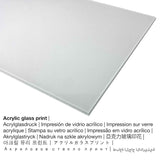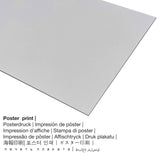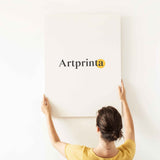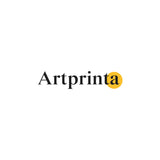Vincent van Gogh, 1890 - Fields in Auvers - fine art print
Taxes incluses. Frais de port calculés au paiement.
Interesting facts about this over 130 year-old painting
The modern art artpiece was painted by the artist Vincent van Gogh in 1890. The artpiece was painted with the size: 50 × 101 cm - frame dimensions: 67 x 118 x 8 cm vitrified and was manufactured with the technique of oil on canvas. What is more, the work of art is in the the Belvedere's art collection in Vienna, Austria. With courtesy of: © Belvedere, Vienna, inventory number: 1007 (license - public domain). : dedication Secession, Vienna in 1909. Furthermore, alignment is in landscape format with a side ratio of 2 : 1, which implies that the length is two times longer than the width. The painter, botanical illustrator, printmaker, drawer Vincent van Gogh was a European artist, whose style can mainly be attributed to Post-Impressionism. The Dutch painter was born in the year 1853 in Zundert, North Brabant, Netherlands and died at the age of 37 in 1890.
Select the item material of your choice
In the dropdown lists next to the article you can select your prefered size and material. We allow yout to choose among the following variants:
- Metal print (aluminium dibond): This is a metal print made on aluminium dibond material with an outstanding depth effect. A direct Direct Print on Aluminum Dibond is your excellent start to fine replicas with aluminum. For your Direct Aluminium Dibond print, we print your selected artpiece onto the aluminium composite white-primed surface.
- Printed poster (canvas material): A poster print is a printed canvas paper with a slight surface finish, which reminds the original version of the masterpiece. Please keep in mind, that depending on the size of the canvas poster print we add a white margin of approximately 2-6 cm round about the painting in order to facilitate the framing.
- The canvas print: A canvas print, not to be mistaken with a painting on a canvas, is an image applied directly on canvas material. A canvas has the sculptural impression of three-dimensionality. How can I hang a canvas on my wall? The advantage of canvas prints is that they are relatively low in weight, meaning that it is easy and straightforward to hang the Canvas print without the help of additional wall-mounts. Canvas prints are suited for any kind of wall.
- The acrylic glass print (with real glass coating): A glossy print on acrylic glass, which is sometimes denoted as a print on plexiglass, will turn your selected original artwork into brilliant décor and forms a distinct alternative to dibond or canvas art prints. Your favorite artwork is custom-made with the help of state-of-the-art UV printing machines.
Important information: We try to depict our art products with as many details as possible and to illustrate them visually. Nonetheless, the tone of the printing material and the imprint might diverge marginally from the image on the monitor. Depending on your screen settings and the condition of the surface, color pigments can unfortunately not be printed as exactly as the digital version on this website. Because all our fine art prints are printed and processed manually, there may also be minor deviations in the size and exact position of the motif.
About the product
| Print prodct: | wall art |
| Reproduction: | reproduction in digital format |
| Production process: | UV direct print |
| Production: | German production |
| Stock type: | on demand production |
| Intended usage: | art print gallery, wall decoration |
| Orientation: | landscape alignment |
| Image aspect ratio: | 2 : 1 length to width |
| Implication: | the length is two times longer than the width |
| Available product fabrics: | metal print (aluminium dibond), acrylic glass print (with real glass coating), poster print (canvas paper), canvas print |
| Canvas on stretcher frame (canvas print) size variants: | 40x20cm - 16x8", 60x30cm - 24x12", 80x40cm - 31x16", 100x50cm - 39x20", 120x60cm - 47x24", 160x80cm - 63x31", 180x90cm - 71x35" |
| Acrylic glass print (with real glass coating): | 40x20cm - 16x8", 60x30cm - 24x12", 80x40cm - 31x16", 100x50cm - 39x20", 120x60cm - 47x24" |
| Poster print (canvas paper) options: | 60x30cm - 24x12", 80x40cm - 31x16", 100x50cm - 39x20", 120x60cm - 47x24" |
| Aluminium dibond print size variants: | 40x20cm - 16x8", 60x30cm - 24x12", 80x40cm - 31x16", 100x50cm - 39x20", 120x60cm - 47x24" |
| Picture frame: | unframed art copy |
Background data on the unique artpiece
| Piece of art name: | "Fields in Auvers" |
| Classification of the artwork: | painting |
| Broad category: | modern art |
| Temporal classification: | 19th century |
| Year of creation: | 1890 |
| Approximate age of artwork: | 130 years old |
| Original medium of artwork: | oil on canvas |
| Dimensions of the original work of art: | 50 × 101 cm - frame dimensions: 67 x 118 x 8 cm vitrified |
| Museum / location: | Belvedere |
| Museum location: | Vienna, Austria |
| Museum's webpage: | www.belvedere.at |
| License type: | public domain |
| Courtesy of: | © Belvedere, Vienna, inventory number: 1007 |
| Artwork creditline: | dedication Secession, Vienna in 1909 |
Background information about the artist
| Artist: | Vincent van Gogh |
| Also known as: | j. van gogh, Gogh, van Gogh Vincent, ゴッホ, Gogh Vincent-Willem van, Fan-ku, Fangu, Fan'gao, Gogh Vincent Willem van, Fangu Wensheng, van gogh, Van-Gog Vint︠s︡ent, Vincent van Gogh, ビンセントゴッホ, Gogh Vincent van, גוג וינסנט ואן, גוך וינסנט ואן, Fan-kao, 梵高, v. van gogh |
| Artist gender: | male |
| Nationality: | Dutch |
| Jobs of the artist: | drawer, botanical illustrator, painter, printmaker |
| Country of the artist: | the Netherlands |
| Artist category: | modern artist |
| Art styles: | Post-Impressionism |
| Died aged: | 37 years |
| Year of birth: | 1853 |
| Birthplace: | Zundert, North Brabant, Netherlands |
| Died in the year: | 1890 |
| Died in (place): | Auvers-sur-Oise, Ile-de-France, France |
© Copyright of - www.artprinta.com (Artprinta)
Original artwork specifications as provided by Belvedere (© Copyright - by Belvedere - Belvedere)
The "Plain of Auvers" is one of the twelve works that form a cycle of rural life and were color coordinated by Van Gogh. So he wrote to his brother Theo that "this extremely makes good next to another in widescreen format, in addition to 'wheat fields' - because the image is a portrait and pink, the other pale green and yellow green, complementary colors to pink." Impressively the picture is the large expanse of the landscape. It acts as reduced to a few large-seen forms that identify the characteristics of the area. The blue-green sky does not convey the glow of a clear day, but rather the mood after the rain or on a cloudy day. The strong low flight, the highly-term horizon and the space gained by overlapping convey the simplest means an impression of the hilly country around Auvers. In addition, the color perspective of always uniform blue green expectant tones against the horizon, while the foreground the bright colors full of freshness and increase in its rich diversity of each other. The image - a masterpiece of the artist - appears more subtle in the invoice as well as in color and more refined than many other paintings of the last few weeks Van Gogh. [Stephan Koja, in: Austrian Gallery Belvedere Vienna, Prestel museum guide, Munich et al 2001] The image was acquired in 1903 as part of the Impressionist exhibition of Secession by some members and supporters of the artists' association for the purpose of dedication to the Modern Gallery, but initially remained at the Secession and not get into the few months later opened Permanent Collection of Modern Gallery in the Lower Belvedere. The Secession had initially postponed the dedication because of yet unknown conditions of the new museum. Only an inquiry Gustav Klimt to the Ministry of Culture and Education with a request for loan from the International Art Show in 1909, which was answered in the negative because the picture still was not in state ownership, gave the dedication rolling again. That same year, the picture was inventoried in the existence of the Modern Gallery. [Markus Fellinger, 09/2019]














